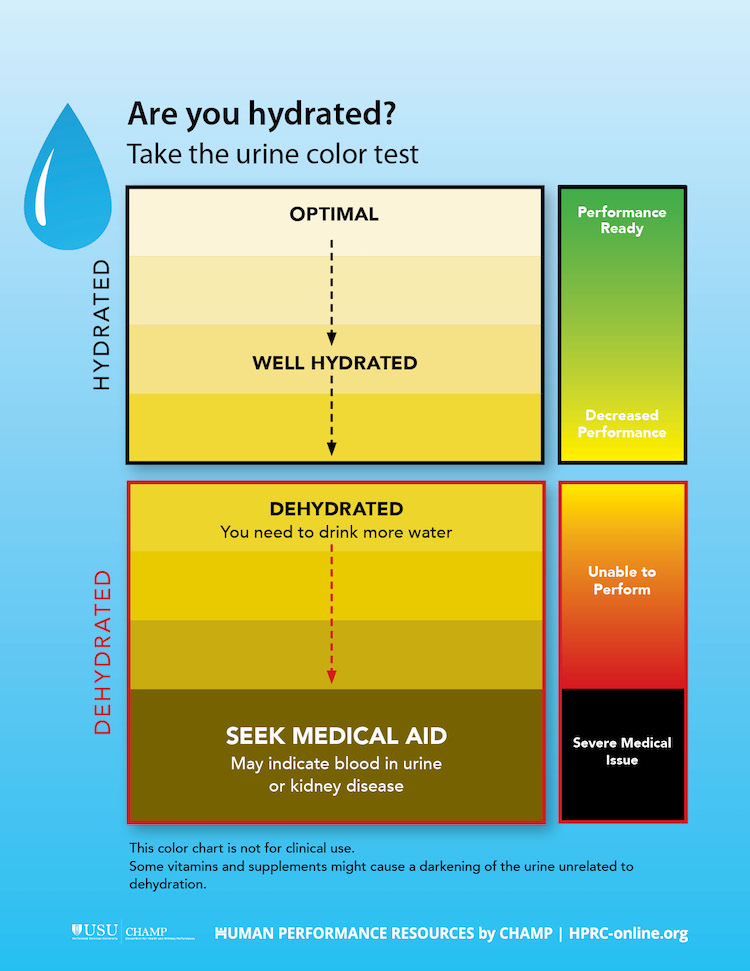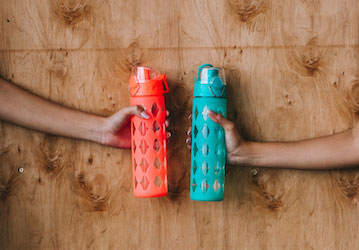Water is one of the most important nutrients your body needs to function optimally. Dehydration occurs when you don’t replace the fluids you lose. Even as little as 2% dehydration is enough to affect both your physical and mental performance negatively.
Daily fluid needs
You might have heard you need to drink 8 cups or half your body weight in ounces of water each day. These are helpful guidelines, but each person’s daily fluid needs are different and depend on many factors, including:
- Environment (temperature, humidity, altitude)
- Body size (height, weight, body fat, lean mass)
- Type, intensity, and duration of exercise
- Individual sweat rate
- Electrolytes lost in sweat
- Clothing and equipment worn
Given the unique nutritional requirements of Warfighters, the general fluid guidelines in the military are:
- Men: 96–144 oz daily (12–18 cups)
- Women: 64–96 oz daily (8–12 cups)
Keep in mind that thirst isn’t always the most reliable indicator of how hydrated you are. If you’re exercising in a hot environment, you’ll likely be dehydrated by the time you feel thirsty. An easy way to see how hydrated you are is to use the urine color chart below.

Fluids for exercise
Proper hydration before, during, and after exercise is key to optimal exercise performance. Because fluid needs are unique to each person, adjust your intake based on your exercise environment and how much you sweat. The following guidelines can help you properly hydrate for physical activity:
- Before: Drink 14–22 oz of fluid 2–4 hours prior to exercise.
- During: Drink 16–32 oz of fluid every 60 minutes during exercise.
- After: Drink 20–24 oz of fluid for every pound lost during exercise.
For exercise less than 1 hour, water is the best choice to maintain hydration. If you exercise longer than 1 hour, or if your exercise environment is particularly hot and humid, consider a sports drink to help replace electrolytes, especially sodium. Sodium is the main electrolyte lost in sweat. It’s important because it helps you retain fluid.
Proper hydration is also a performance-nutrition strategy that can help lower your risk of heat illness and rhabdomyolysis. Avoid drinking more than 48 oz per hour, because this can contribute to low sodium levels in the blood, or hyponatremia.
Chapter 5 of HPRC’s Warfighter Nutrition Guide provides more detailed information about hydration and electrolytes. Other chapters offer guidelines for how to fuel for exercise.
Tips to stay hydrated
If you find it hard to meet your daily fluid needs, the following tips might help:
- Invest in a good-quality water bottle, and keep it with you throughout the day. Consider bottles that have measurements on them so you can see how much you drink.
- Sip, don’t chug! Take small sips of fluids frequently throughout the day.
- Add lemon, lime, berries, or cucumber to water for flavor.
- In hot or humid environments, choose cool, flavored beverages with added sodium.
- Set a timer to remind yourself to drink at regular intervals.
- Eat foods with high water content, such as melon, cucumbers, grapes, or tomatoes.
- Choose other nutrient-dense fluids, such as milk, milk alternatives, 100% vegetable juice, or unsweetened tea. HPRC’s article on hydration beverages can help you decide which beverages best fit your performance needs.
